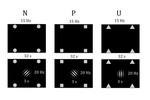Visuocortical correlates of sensory processing during aversive learning

How does aversive learning shape sensory mechanisms to adapt to changing environments? Attention to threat is vital for supporting defensive behavior in threatening situations. Here, we use direct measures of brain activity to index attentional processing of threatening stimuli. Our major goal is to contribute to the understanding of how threatening stimuli are processed in the brain and to elucidate sensory mechanisms underlying defensive behavior. We assume that adapting sensory mechanisms to the characteristics of the environment is a fundamental function of the brain. However, a dysruption of this function could contribute to the development and maintenance of psychiatric disorder, in particular of mood and anxiety disorders, which are characterized by a dysfunctional processing of emotional stimuli.
In this project, we try to develop, test and establish new methods and paradigms to investigate sensory mechanisms in healthy individuals. We record brain activity via EEG to index sensory processing during aversive learning paradigms. To assess defensive responding on a multimodal level, we also measure behavioral and psychophysiological components of the human defense system.
Recently, we have begun using online methods.



